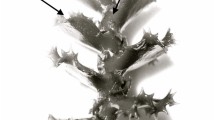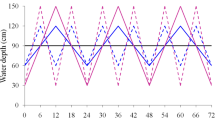Abstract
In stream ecosystems, the growth of aquatic primary producers is affected by spatial and temporal variations in the riparian canopy, which can influence the availability of light resources. Aquatic plants can acclimate to low light environments by employing a suite of morphological or physiological mechanisms to increase light capture or photosynthetic efficiency. Some species may also use alternate types of propagules to colonize environments with heterogeneous light environments. In a greenhouse experiment we examined the morphological and physiological response of watercress (Nasturtium officinale R. Br.) to a gradient of increasing light levels, which ranged from 7% ambient light to full sunlight. We also determined if watercress seedlings and vegetative fragments differed in their growth response to increasing light levels. Total biomass and root biomass of seedlings and vegetative fragments decreased with decreasing light levels. The difference in plant biomass across treatments was due to morphological changes in total canopy area and leaf area, both of which increased with decreasing light levels. Seedlings and vegetative fragments did not differ in their response to light availability, but vegetative fragments had higher final biomass as a result of higher initial biomass. Physiological acclimation to low light levels appears to be of secondary importance for watercress as the concentrations of total chlorophyll, chlorophyll a, chlorophyll b, and chlorophyll a:b did not differ among light levels or between seedlings and vegetative fragments. Seedlings and vegetative fragments grown under high light levels had a greater percentage of carbon and a lower percentage of nitrogen than plants grown under low light conditions. The results of this study indicate that watercress displays considerable morphological plasticity and acclimates to low light conditions primarily by increasing leaf area and canopy surface area. There is no evidence that the type of watercress propagule (seedling vs. vegetative fragment) imparts any growth advantage in low light environments and watercress grown from either type of propagule showed no differences in their morphological or physiological responses to varying light regimes.




Similar content being viewed by others
References
Aikio, S. & A. M. Markkola, 2002. Optimality and phenotypic plasticity of shoot-to-root ratio under variable light and nutrient availabilities. Evolutionary Ecology 16: 67–76.
Agusti, S., S. Enriquez, H. Frost-Christensen, K. Sand-Jensen & C. M. Duarte, 1994. Light harvesting among photosynthetic organisms. Functional Ecology 8: 273–279.
Balaguer, L., E. Martínez-Ferri, F. Valladares, M. E. Pérez-Corona, F. J. Baquedano, F. J. Castillo & E. Manrique, 2001. Population divergence in the plasticity of the response of Quercus coccifera to the light environment. Functional Ecology 15: 124–135.
Barko, J. W. & G. J. Filbin, 1983. Influences of light and temperature on chlorophyll composition in submerged freshwater macrophytes. Aquatic Botany 15: 249–255.
Barko, J. W. & R. M. Smart, 1981. Comparative influences of light and temperature on the growth and metabolism of selected submersed freshwater macrophytes. Ecological Monographs 51: 219–235.
Barrat-Segretain, M. H., 1996. Strategies of reproduction, dispersal, and competition in river plants: a review. Vegetatio 123: 13–37.
Blanche, S. J., G. G. Ganf & K. F. Walker, 1998. Growth and recruitment in Vallisneria americana as related to average irradiance in the water column. Aquatic Botany 61: 181–205.
Bloom, A. J., F. S. Chapin & H. A. Mooney, 1985. Resource limitation in plants-an economic analogy. Annual Review of Ecology and Systematics 16: 363–392.
Boardman, N. K., 1977. Comparative photosynthesis of sun and shade plants. Annual Review of Plant Physiology 28: 355–377.
Botts, P. S., J. M. Lawrence, B. W. Witz & C. W. Kovach, 1990. Plasticity in morphology, proximate composition and energy content of Hygrophila polysperma (Roxb.) Anders. Aquatic Botany 36: 207–214.
Boyd, C. E., 1970. Chemical analyses of some vascular aquatic plants. Archives Hydrobiologia 67: 78–85.
Buisson, D. & D. W. Lee, 1993. The developmental responses of papaya leaves to stimulated canopy shade. American Journal of Botany 80: 947–952.
Cenzato, D. & G. G. Ganf, 2001. A comparison of growth responses between two species of Potamogeton with contrasting canopy architecture. Aquatic Botany 70: 53–66.
Chambers, P. A. & J. Kalff, 1987. Light and nutrients in the control of aquatic plant community structure. I. In situ experiments. Journal of Ecology 75: 611–619.
Cronin, G. & D. M. Lodge, 2003. Effects of light and nutrient availability on the growth, allocation, carbon/nitrogen balance, phenolic chemistry, and resistance to herbivory of two freshwater macrophytes. Oecologia 137: 32–41.
De Winton, M. D., M. T. Casanova & J. S. Cayton, 2004. Charophyte germination and establishment under low irradiance. Aquatic Botany 79: 175–187.
Dennison, W. C. & R. S. Alberte, 1982. Photosynthetic responses of Zostera marina L. (eelgrass) to in situ manipulation of light intensity. Oecologia 55: 137–144.
Dunton, K. H., 1994. Seasonal growth and biomass of the subtropical seagrass Haloduli wrightii in relation to continuous measurements of underwater irradiance. Marine Biology 120: 479–489.
Enriquez, S. & K. Sand-Jensen, 2003. Variation in light absorption properties of Mentha aquatica L. as a function of leaf form: implications for plant growth. International Journal of Plant Sciences 164: 125–137.
Evans, J. R., 1989. Photosynthesis and nitrogen relationships in leaves of C3 plants. Oecologia 78: 9–19.
Everitt, D. T. & J. M. Burkholder, 1991. Seasonal dynamics of macrophyte communities from a stream flowing of granite flatrock in North Carolina, USA. Hydrobiologia 222: 159–172.
Gleeson, S. K. & D. Tilman 1992. Plant allocation and the multiple limitation hypothesis. The American Naturalist 139: 1322–1343.
Goldsborough, W. J. & W. M. Kemp 1988. Light responses of a submerged macrophyte: implications for survival in turbid tidal waters. Ecology 69: 1775–1786.
Grace, J. B., 1993. The adaptive significance of clonal reproduction in angiosperms: an aquatic perspective. Aquatic Botany 44: 159–180.
Hanba, Y. T., H. Kogami & L. Terashima, 2002. The effect of growth irradiance on leaf anatomy and photosynthesis in Acer species differing in light demand. Plant, Cell and Environment 25: 1021–1030.
Howard, H. W. & A. G. Lyon 1952. Biological flora of the British Isle. Journal of Ecology 40: 228–245.
Jeffrey, S. W. & G. F. Humphrey, 1975. New spectrophotometric equations for determining chlorophylls A, B, C1 and C2 in higher plants, algae, and natural phytoplankton. Biochemie und Physiologie der Pflanzen 167: 191–194.
Kimbel, J. C., 1982. Factors influencing potential intralake colonization by Myriophyllum spicatum L. Aquatic Botany 14: 295–307.
Kudoh, H., Y. Ishiguri & S. Kawano, 1995. Phenotypic plasticity in Cardamine flexuosa: variation among populations in plastic response to chilling treatments and photoperiods. Oecologia 103: 148–156.
Kuster, A., R. Schaible & H. Schubert, 2000. Light acclimation of the charophyte Lamprothamnium papulosum. Aquatic Botany 68: 205–216.
Madsen, J. D. & M. S. Adams, 1989. The distribution of submerged aquatic macrophyte biomass in a eutrophic stream, Badfish Creek: the effect of environment. Hydrobiologia 171: 111–119.
McConnaughay, K. D. M. & J. S. Coleman, 1999. Biomass allocation in plants: ontogeny or optimality? A test along three resource gradients. Ecology 80: 2581–2593.
Michaelis, F. B., 1976. Watercress (Nasturtium microphyllum (Boenn,) Rchb. And N. officinale) in New Zealand cold springs. Aquatic Botany 2: 317–325.
Mielecki, M. & E. Pieczynska, 2005. Influence of fragmentation on the growth of Elodea canadensis Michx. in different light conditions. Polish Journal of Ecology 53: 155–164.
Oshima, K., Y. Tang & I. Washitani, 1997. Spatial and seasonal patterns of microsite light availability in a remnant fragment of deciduous riparian forest and their implications in the conservation of Arisaema heterophyllum, a threatened plant species. Journal of Plant Research 110: 321–327.
Pilon, J. & L. Santamaria, 2002. Clonal variation in morphological and physiological responses to irradiance and photoperiod for the aquatic angiosperm Potamogeton pectinatus. Journal of Ecology 90: 859–870.
Sabater, S., H. Guasch, I. Muñoz & A. Romani, 2006. Hydrology, light and the use of organic and inorganic materials as structuring factors of biological communities in Mediterranean streams. Limnetica 25: 335–348.
Sand-Jensen, K. & T. V. Madsen, 1991. Minimum light requirements of submerged freshwater macrophytes in laboratory growth experiments. Journal of Ecology 79: 749–764.
Santamaria, L., 2002. Why are most aquatic plants widely distributed? Dispersal, clonal growth and small-scale heterogeneity in a stressful environment. Acta Oecologia 23: 137–154.
Spence, D. H. N., R. M. Campbell & J. Chrystal, 1972. Specific leaf areas and zonation of freshwater macrophytes. Journal of Ecology 61: 317–328.
Strand, J. A. & S. E. B. Weisner, 2001. Morphological plastic responses to water depth and wave exposure in an aquatic plant (Myriophyllum spicatum). Journal of Ecology 89: 166–175.
Stuefer, J. F. & H. Huber, 1998. Differential effects of light quantity and spectral light quality on growth, morphology and development of two stoloniferous Potentilla species. Oecologia 177: 1–8.
Tavechio, W. L. G. & S. M. Thomaz, 2003. Effects of light on the growth and photosynthesis of Egeria najas Planchon. Brazilian Archives of Biology and Technology 46: 203–209.
Titus, J. E. & M. S. Adams, 1979. Coexistence and the comparative light relations of the submersed macrophytes Myriophyllum spicatum L. and Vallisneria americana Michx. Oecologia 40: 273–286.
Titus, J. E. & D. T. Hoover, 1991. Towards predicting reproductive success in submerged freshwater angiosperms. Aquatic Botany 41: 111–136.
Vojtĩsková, L., E. Munzarová, O. Votrubová, A. Řihová & B. Juřicová, 2004. Growth and biomass allocation of sweet flag (Acorus calamus L.) under different nutrient conditions. Hydrobiologia 518: 9–22.
Vretare, V., S. E. B. Weisner, J. A. Strand & W. Graneli, 2001. Phenotypic plasticity in Phragmites australis as a functional response to water depth. Aquatic Botany 69: 127–145.
Winn, A. A. & A. S. Evans, 1991. Variation among populations of Prunella vulgaris L. in plastic responses to light. Functional Ecology 5: 562–571.
Acknowledgments
We are grateful to Scott Cooper for advice on statistical analyses and for conversations that improved our interpretations. The manuscript was greatly improved by comments from three anonymous reviewers. Financial support for this work was provided by a mentoring grant from Susan and Bruce Worster awarded to BG and JS; the Santa Barbara Coastal LTER (grant no. OCE99-82105) provided additional funding.
Author information
Authors and Affiliations
Corresponding author
Additional information
Handling editor: S. M. Thomaz
Rights and permissions
About this article
Cite this article
Going, B., Simpson, J. & Even, T. The influence of light on the growth of watercress (Nasturtium officinale R. Br.). Hydrobiologia 607, 75–85 (2008). https://doi.org/10.1007/s10750-008-9368-2
Received:
Revised:
Accepted:
Published:
Issue Date:
DOI: https://doi.org/10.1007/s10750-008-9368-2




